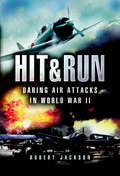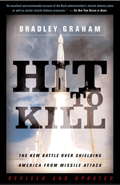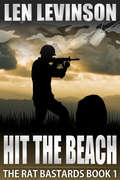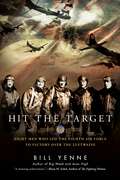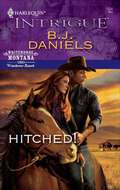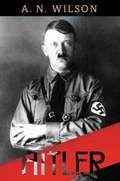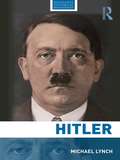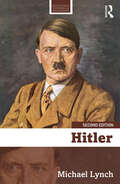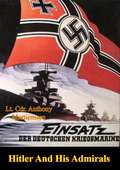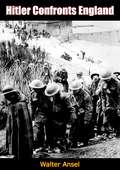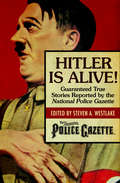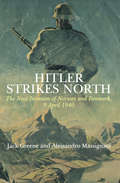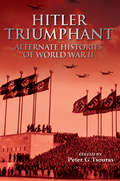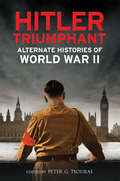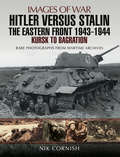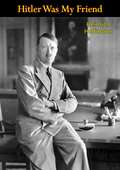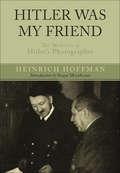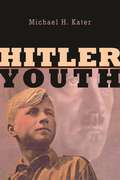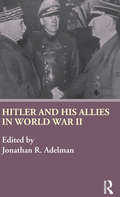- Table View
- List View
History's Most Important Racing Aircraft
by Don BerlinerDon Berliner, a prolific aviation author, puts pen to paper once again to provide us with a definitive overview of the most important, influential, and iconic racing aircraft of the last century. The book looks at the incredible variety, growth, and rapid expansion of this area of aviation design and production. Individual events are relayed which deal with teams of designers, often equipped with a lot more ideas than money, making wild dashes for the checkered flag and fame. The excitement of this endeavor is translated here into vivid prose. Supplemented throughout by extensive illustrations (over 200 images) this piece of work is sure to appeal to enthusiasts of the genre interested in seeing the most select racing aircraft of all time consolidated into one volume.Aircraft featured include the Schneider Cup winning 1919 Supermarine Sealion, the iconic De Havilland Comet, post-war jet racers such as the Lockheed P-80A and the North American F-86A as well as a whole host of Formula One, Sport Biplane and Jet Class racers. Details of the current status of each racer is given, indicating whether the craft is still active or whether preserved models are available for viewing. Berliner continues with characteristic style and ease of delivery, adding to his expanding library of acclaimed Pen & Sword publications.
History: A Novel
by William Weaver Lily Tuck Elsa MoranteHistory was written nearly thirty years after Elsa Morante and Alberto Moravia spent a year in hiding among remote farming villages in the mountains south of Rome. There she witnessed the full impact of the war and first formed the ambition to write an account of what history - the great political events driven by men of power, wealth, and ambition - does when it reaches the realm of ordinary people struggling for life and bread. The central character in this powerful and unforgiving novel is Ida Mancuso, a schoolteacher whose husband has died and whose feckless teenage son treats the war as his playground. A German soldier on his way to North Africa rapes her, falls in love with her, and leaves her pregnant with a boy whose survival becomes Ida's passion. Around these two other characters come and go, each caught up by the war which is like a river in flood. We catch glimpses of bombing raids, street crimes, a cattle car from which human cries emerge, an Italian soldier succumbing to frostbite on the Russian front, the dumb endurance of peasants who have lived their whole lives with nothing and now must get by with less than nothing.
Hit & Run: Daring Air Attacks in World War II
by Robert JacksonThe book describes some of the most daring air attacks of World War II. Some were outstanding successes and some were unmitigated disasters. North Sea Battle: In the early weeks of World War II, Britain and Germany were determined to attack one another's warships in their respective naval bases. Both RAF and Luftwaffe learned the folly of sending unescorted bombers into enemy territory. Flames over France: In May 1940, the RAF and French Air Force launched a series of desperate hit-and-run attacks on the German armored columns advancing into France and Belgium. The cost was appalling. Precision Attack: In August 1940, a newly-formed Luftwaffe unit called Erprobungsgruppe 210 (Test Group 210), equipped with bomb-carrying Messerschmitts, was assigned a mission to wipe out British radar stations in a series of lightning low-level attacks. Carrier Strike: In November 1940, a force of Fairey Swordfish torpedo-bombers crippled the Italian fleet in a daring night attack on the naval base at Taranto. By Daylight to Germany: In the summer of 1941, Blenheim squadrons of No 2 Group RAF launched a series of daring low-level attacks on power stations and naval facilities in northern Germany. The principal target was Bremen, at the extreme limit of the bombers' range. Plus ... Mission to Augsburg, Target Tokyo, Dead on Time, Extreme Danger Mission, The Raid That Failed, The Anniversary Raids, Mosquito Mission, The Luftwaffe's Last Fling
Hit Man: A Sexy Action-Packed Alpha Adventure Romance
by Michele MannonHe always gets what he wants.The seasoned seducer, who probably charms the panties off of every woman he meets. Diego is handsome. Arrogant. Dangerous. Far more dangerous than anyone I've ever met. And with one look from across a crowded room he has me; hook line and sinker, I'm his for the night.Diego is not a man to mess with, I know that. I just can't seem to resist his kiss, his touch. But can I trust him with my heart, with my body?I'm being hunted for something I may or may not have seen, and Diego is my only way out of a world of death and destruction. If only I can believe his dark promises.
Hit To Kill: The New Battle Over Shielding America From Missile Attach
by Bradley GrahamEven as America faces a world of difficult-to-detect, low-tech, unconventional threats, the Bush administration has put its faith in a missile defense system or shield to keep us all safe. There ar
Hit To Kill: The New Battle Over Shielding America From Missile Attack
by Bradley GrahamWhat constitutes the best defense?
Hit the Beach
by Len LevinsonThey love to fight and live to kill! Start with an insane sergeant with a genius for leadership and a lust for blood. Add a bank robber. A racketeer. A guy who goes berserk on the battlefield. A gun-happy Texan. A silent Apache. A movie stuntman who swings from trees. Put them all together and you have the killing machine known as...The Rat Bastards.
Hit the Target: Eight Men who Led The Eighth Air Force to Victory over the Luftwaffe
by Bill YenneSelected for the Chief of Staff of the Air Force Reading ListFrom Bill Yenne, author of the military histories Big Week and Aces High, comes the stirring true story of the Eighth Air Force in World War II. Less than a month after the attack on Pearl Harbor, the U.S. Army formed its first air force designated to operate overseas, the Eighth. Within four months, they had set up base in England. Three months later, they were bombing German targets in occupied Europe. The Eighth was the first bomber command on either side to commit to strategic daylight bombing. It was a major change in tactics—and the men of the Eighth paid the price in both lives and blood. But it was that very sacrifice that led the Allies to victory. Hit the Target introduces readers to those who made the Eighth Air Force the formidable juggernaut it soon became. Men of all ranks, from General Tooey Spaatz, the hard-driving founding commander, to Colonel Jimmy Doolittle, the hero who led the first air raid on Japan, to Maynard &“Snuffy&” Smith, the irascible first airman in Europe to be awarded the Congressional Medal of Honor, and Robert &“Rosie&” Rosenthal, who survived his time with the &“Bloody Hundredth,&” which lost airmen at a horrifying rate, and who went on to serve as a prosecutor at the Nuremberg Trials. The story of the Mighty Eighth is told through these men, whose careers paralleled the early history of aviation and who helped to revolutionize airborne warfare and win World War II. INCLUDES PHOTOS
Hitched! (Whitehorse, Montana: Winchester Ranch Reloaded #2)
by B.J. DanielsA rancher offers a woman in jeopardy a pretend marriage and his protection in this romantic suspense from a New York Times–bestselling author.Following a trail of secrets back to his family ranch, Jack Winchester needed a cover to solve a decades-old mystery. And Josey Smith offered him the perfect one—if she would agree to pose as his wife for a week. The gorgeous redhead was up to her neck in trouble, and Jack would protect his pretend bride no matter what—real wedding vows or not.On the run from a killer, Josey had no choice but to accept Jack’s proposal. She no longer trusted herself to tell the good guys from the bad, but the handsome, blue-eyed cowboy made her feel safe. Yet it soon became apparent that the sparks that flew between them were anything but fake, and the danger they faced was all too real. . . .
Hitler
by A. N. WilsonA ruthless dictator who saved his country from economic ruin only to nearly destroy it#151;and an entire people#151;in his quest for world domination, Adolf Hitler forever changed the course of history. In this masterful account of Hitler’s life, biographer A. N. Wilson pulls back the curtain to reveal the man behind the mythic figure, shedding new light on Hitler’s personality, his desires, and his complex relationship with the German people. While Hitler maintained that his life had been characterized by #147;struggle” from its very beginnings, Wilson shows that the reality could not have been more different. Hitler grew up in middle-class comfort and, as a young man, lacked ambitions of any sort besides a vaguely bohemian desire to become an artist. And while the Hitlerian mythos holds that he forged his skills as a leader during the First World War, Wilson explains the truth: Hitler spent most of the war as an office boy miles from the front lines, and only received his cherished Iron Cross because of his slavishness to the officers he served. The army gave him a sense of purpose and brotherhood, however, which continued to inspire Hitler once the war ended. Hitler left the army with no skills, contacts, or money#151;and yet, within fourteen years, he would become chancellor of the German nation. Wilson describes the story of Hitler’s ascent as one of both opportunism and sheer political shrewdness. He possessed no real understanding of the workings of government but had a prodigious knack for public speaking, and found that a large number of Germans, despairing at their country’s recent defeat and terrified by the specter of international communism, were willing to listen to the right-wing fantasies that had taken root inside his head. Allying himself with the extremist German Workers’ Party (soon renamed the National Socialist Party), Hitler offered many Germans a seductive vision of how the country might raise itself back up and reclaim its rightful place at the center of world politics. Wilson shows that, although Hitler’s bid for power stalled at first, he soon gained traction with a German public starved for hope. Using his skills as a manipulator, Hitler found himself first at the head of the Nazi Party, then at the helm of the German nation. Wilson explores the forces that allowed Hitler to become Chancellor of Germany, and later to march Germany into total war. He examines Hitler’s increasingly virulent anti-Semitism and his decision to implement the Final Solution to exterminate European Jews, and he considers Hitler’s tactical successes#151;and failures#151;in World War II. Wilson also reveals a great deal about how Hitler’s personal life affected his time as Germany’s leader, from the lasting pain caused by the death of his mother and the suicide of his young niece to his poor health and addiction to the drugs prescribed by his doctor. As Wilson demonstrates, Hitler the Führer was not so different from Hitler the bohemian: lazy, moody, and hypersensitive, he ruled more through intimidation and the mystifying force of his personality than through any managerial skill or informed decision-making. His story#151;and that of Germany#151;is ultimately a cautionary tale. In a modern era enamored with progress, rationality, and modernity, it is often the darkest and most chaotic elements of society that prove the most seductive. Hitler’s unlikely rise to power and his uncanny ability to manipulate his fellow man resulted in the deaths of millions of Europeans and a horrific world war, yet despite his colossal role in world history, he remains mythologized and, as a result, misunderstood. In Hitler, A. N. Wilson limns this mysterious figure with great verve and acuity, showing that it was Hitler’s frightening normalcy#151;not some otherworldly evilness#151;that makes him so truly terrifying.
Hitler (Routledge Historical Biographies)
by Michael LynchAdolf Hitler is the most notorious political figure of the twentieth century. The story of his life, how he became a dictator, and how he managed to convince so many to follow his cause is a subject of perennial fascination. Balancing narrative and analysis, this biography employs a chronological approach to describe the main features of Hitler’s career. Set against the background of developments in Germany and Europe during his lifetime, the text tells the extraordinary story of how an Austrian layabout rose to become Führer of the Third Reich. The chapters incorporate into their narrative the major debates surrounding Hitler’s ideas, behaviour and historical significance. Particular attention is paid to his experience as a soldier in 1914 -18 and to the reasons why his original left-wing sympathies transmuted into Nazism. Arguments over the real character of Hitler’s dictatorship are analysed and a measured assessment is offered on the disputed issues of how far Hitler initiated the Third Reich’s domestic and foreign policies himself and to what extent he was controlled by events. His destructive leadership of wartime Germany is now a subject of close scrutiny among historians and the book’s final chapters deal with this theme and offer a set of reflections on Hitler’s relationship with the German people and his legacy to the German nation. Michael Lynch provides a balanced guide to this most difficult of figures that will be enlightening for students and general readers alike
Hitler (Routledge Historical Biographies)
by Michael LynchAdolf Hitler is the most notorious political figure of the twentieth century. The story of his life, how he became a dictator, and how he managed to convince so many to follow his cause is a subject of perennial fascination. Balancing narrative and analysis, this biography employs a chronological approach to describe the main features of Hitler’s career. Set against the background of developments in Germany and Europe during his lifetime, the text tells the extraordinary story of how an Austrian layabout rose to become Führer of the Third Reich.This second edition has been fully updated to incorporate the research and literature from the last ten years, including several major studies by British and German scholars that have added to our understanding of Hitler and the Third Reich. New light has been shed on the character of National Socialism and on Hitler as a person and a political figure. Fresh insights have been made into the Hitler cult and into the charismatic nature of Hitler’s rule over Germany. Modern historians continue to wrestle with questions that still demand an answer – why did the nation that had made a unique contribution to European culture willingly follow Hitler on his nihilistic path? Using an essentially narrative approach to the Hitler story, the new edition incorporates the key findings of current research into the political, socio-economic and military features of the Third Reich that Hitler sought to create before his irrationalities destroyed it. Referencing the major historiographical disputes and drawing on the new perspectives that modern research provides, this second edition addresses the issues that historians regard as central to the study of Hitler’s Germany.Michael Lynch provides a balanced guide to this most difficult of figures that will be enlightening for students and general readers alike.
Hitler And His Admirals
by Lt. Cdr. Anthony MartienssenA fascinating and penetrating portrait of the Kriegsmarine and their relationship with Nazi Germany and Hitler."In this present book I have combined the evidence given at Nuremberg with the material contained in the Führer Conferences on Naval Affairs. It is impossible to cover every aspect of the war in one volume, and I have confined myself to the history, naval and political, which is, I think, a most revealing side of Nazi Germany."I must warn the reader that, as this history deals mainly with strategy and diplomacy, there are only a few examples of individual Nazi crimes. It should be borne in mind that the Nazis imprisoned, murdered and tortured--at a conservative estimate--twelve million people."It is also inevitable that Hitler should emerge from these pages as a talented and very able man. He was the sole ruler of a powerful, modern nation for twelve years, and obviously he could not have been a fool; but lest there are some who think that cleverness is the sole criterion of greatness, I should like to quote from Hitler's sixteenth-century tutor, Nicolo Machiavelli: "Yet it cannot be called talent to slay fellow-citizens, to deceive friends, to be without faith, without mercy, without religion....His barbarous cruelty and inhumanity with infinite wickednesses do not permit him to be celebrated among the most excellent men. What he achieved cannot be attributed either to fortune or to genius.""
Hitler Confronts England
by Walter AnselIn the fateful summer of 1940 Germany stood astride a prostrate Europe while the world held its breath and wondered, “Where next?” Hitler’s war machine had smashed Poland the previous fall, and the dull months of “Sitzkrieg” which followed had gradually lulled the Allies into anticipation of settlement. Then, in the spring, the German legions had suddenly burst into Denmark and Norway and through the Low Countries and France to the Channel coast. What could stop them?The German leader, Adolf Hitler, had rolled up an immense strategic initiative. It seemed plain that England came next. He mounted a powerful invasion force at the Channel. The troops trained and drilled, the ships formed and reformed. Yet the operation never sailed on its mission. “Why Not?” has been a tantalizing question ever since. The full answer may never be given. In it may lurk the first signs of Germany’s eventual defeat.Other studies have presented the problem through the events and their documentation. This book treats it along two distinct but related lines: along the line of a running evaluation of the German leadership and the command relationships that that leadership imposed, and along the line of an examination of the German invasion capability as judged by a naval officer long experienced in amphibious warfare.As a Forrestal Fellow of the U. S. Naval Academy during 1952 and 1953, Admiral Ansel consulted high and low participants of the invasion planning, ordering mounting, and drilling. He found little doubt about the seriousness of the German effort. He was able to discuss with the men involved the import of, and interpretation placed on, the orders and plans issued. From these factors he was enabled to bring his own professional judgment to bear on the operation’s prospects.
Hitler Is Alive!: Guaranteed True Stories Reported by the National Police Gazette (Police Gazette #1)
by Steven A. WestlakeActual articles from the notorious sensationalist journal that was a forerunner to the scandal sheets and tabloids of today: &“Ridiculous alt-history fun&” (Booklist). As the Allied armies closed in on Berlin, the Nazi high command scrambled to escape their shattered city. On May 1, 1945, reports went out that Adolf Hitler and his mistress, Eva Braun, committed suicide in an underground bunker—but their bodies were never found. In this landmark exposé by the legendary National Police Gazette, the truth is finally told. As peace fell across Europe, two U-Boats made mad dashes for Argentina, remaining underwater for weeks at a time to evade detection. In their incredible journeys lies the shocking secret of how the greatest mass murderer in history escaped punishment for his crimes. In the aftermath of World War II, the Police Gazette ruthlessly investigated any rumor of Hitler&’s survival in South America. Hitler Is Alive! is a true epic of twentieth-century sensationalism.
Hitler Strikes North: The Nazi Invasion of Norway and Denmark, 9 April 1940
by Jack Greene Alessandro MassignaniA detailed account of Germany&’s groundbreaking Operation Weserübung, the first three dimensional—land, sea, air—strategic invasion in history. The German invasion of Denmark and Norway in April 1940 brought a sudden and shocking end to the &“Phoney War&” in the West. In a single day, multiple seaborne and airborne landings established German forces ashore in Norway, overwhelming the unprepared Norwegian forces and catching the Allied Powers completely by surprise. Their belated response was ill-thought-out and badly organized, and by June 9 all resistance had formally ended. The strategic importance of Scandinavian iron ore, shipped through the port of Narvik to Germany, was the main cause of the campaign. The authors show how Allied attempts to interdict these supplies provoked German plans to secure them, and also how political developments in the inter-war years resulted in both Denmark and Norway being unable to deter threats to their neutrality despite having done so successfully in the First World War. The German attack was their first &“joint&” air, sea, and land operation, making large-scale use of air-landing and parachute forces, and the Luftwaffe&’s control of the air throughout the campaign would prove decisive. Although costly, particularly for the Kriegsmarine, it was a triumph of good planning, improvisation and aggressive, determined action by the troops on the ground. Making full use of Norwegian, Danish, and German sources, this book is a full and fascinating account of this highly significant campaign and its aftermath both for the course of the Second World War and the post-war history of the two countries conquered with such unprecedented speed.
Hitler Triumphant: Alternate Decisions of World War II
by Peter G. TsourasEdited by the author of Disaster at D-Day, a collection of alternative histories that force readers to consider what could happen if the Nazis won World War II. Based on a series of fascinating &“what ifs&” posed by leading military historians, this compelling new alternate history reconstructs the moments during the Second World War that could conceivably have altered the entire course of the war and led to a German victory. Based on real battles, actions, and characters, each scenario has been carefully constructed to reveal how at points of decision a different choice or minor incident could have set in motion an entirely new train of events altering history forever. Scenarios in this volume include the fall of Malta in 1942 and the likely consequences and the possibility of Halifax making peace with Hitler. Contributors include John Prados, editor of The White House Tapes: Eavesdropping on the President; David Isby, editor of Fighting the Invasion and The Luftwaffe Fighter Force; and Nigel Jones, author of The War Walk and Rupert Brooke: Life, Death and Myth.Praise for Hitler Triumphant&“An entertaining work of counter-factual history, with some thought-provoking material on the overall course of the war.&” —History of War&“The analysis of battle strategy and military might makes for a top pick for military readers seeking more than fantasy speculation.&” —Midwest Book Review
Hitler Triumphant: Alternate Histories of World War II
by Peter G. TsourasEdited by the author of Disaster at D-Day, a collection of alternative histories that force readers to consider what could happen if the Nazis won World War II.What if Winston Churchill's plane had been shot down and Halifax had become Prime Minister? Or what if Goering had taken power after a successful assassination of Hitler? Or what if Italy had not joined the Third Reich and the Axis?Inspired by a series of hypothetical questions posed by leading military historians, this compelling collection of alternate histories rewrites moments in World War II that could conceivably have altered the entire course of the war and led to a German victory.Based on real battles, actions, and characters, each scenario has been carefully constructed to reveal how different decisions or minor incidents could have set in motion an entirely new chain of events, altering history forever. Other scenarios in this volume include the fall of Malta in 1942, a successful Stalingrad breakout, and a disastrous attempt to open a second front on the Cherbourg peninsula in 1943.Contributors include John Prados, editor of The White House Tapes: Eavesdropping on the President; David Isby, editor of Fighting the Invasion and The Luftwaffe Fighter Force; and Nigel Jones, author of The War Walk and Rupert Brooke, Life, Death and Myth.Praise for Hitler Triumphant“An entertaining work of counter-factual history, with some thought-provoking material on the overall course of the war.” —History of War“The analysis of battle strategy and military might makes for a top pick for military readers seeking more than fantasy speculation.” —Midwest Book Review
Hitler Triumphant: Alternate Histories of World War II
by Peter G. TsourasEdited by the author of Disaster at D-Day, a collection of alternative histories that force readers to consider what could happen if the Nazis won World War II.What if Winston Churchill's plane had been shot down and Halifax had become Prime Minister? Or what if Goering had taken power after a successful assassination of Hitler? Or what if Italy had not joined the Third Reich and the Axis?Inspired by a series of hypothetical questions posed by leading military historians, this compelling collection of alternate histories rewrites moments in World War II that could conceivably have altered the entire course of the war and led to a German victory.Based on real battles, actions, and characters, each scenario has been carefully constructed to reveal how different decisions or minor incidents could have set in motion an entirely new chain of events, altering history forever. Other scenarios in this volume include the fall of Malta in 1942, a successful Stalingrad breakout, and a disastrous attempt to open a second front on the Cherbourg peninsula in 1943.Contributors include John Prados, editor of The White House Tapes: Eavesdropping on the President; David Isby, editor of Fighting the Invasion and The Luftwaffe Fighter Force; and Nigel Jones, author of The War Walk and Rupert Brooke, Life, Death and Myth.Praise for Hitler Triumphant“An entertaining work of counter-factual history, with some thought-provoking material on the overall course of the war.” —History of War“The analysis of battle strategy and military might makes for a top pick for military readers seeking more than fantasy speculation.” —Midwest Book Review
Hitler Versus Stalin: Kursk to Bagration (Images of War)
by Nik CornishThe third volume in Nik Cornishs photographic history of the Second World War on the Eastern Front records in vivid visual detail the sequence of Red Army offensives that pushed the Wehrmacht back across Russia after the failure of Operation Citadel, the German attack at Kursk. Previously unpublished images show the epic scale of the build-up to the Kursk battle and the enormous cost in terms of lives and material of the battle itself. They also show that the military initiative was now firmly in Soviet hands, for the balance of power on the Eastern Front had shifted and the Germans were on the defensive and in retreat. Subsequent chapters chronicle the hard-fought and bloody German withdrawal across western Russia and the Ukraine, recording the Red Armys liberation of occupied Soviet territory, the recovery of key cities like Orel, Kharkov and Kiev, the raising of the siege of Leningrad and the advance to the borders of the Baltic states. Not only do the photographs track the sequence of events on the ground, they also show the equipment and weapons used by both sides, the living conditions experienced by the troops, the actions of the Soviet partisans, the fight against the Finns in the north, the massive logistical organization behind the front lines, and the devastation the war left in its wake.
Hitler Victorious
by Gregory Benford Martin GreenbergEleven Stories of the German Victorie in World War II.
Hitler Was My Friend: The Memoirs Of Hitler's Photographer
by Heinrich Hoffmann Lt.-Col. R. H. StevensHeinrich Hoffmann was the photographer to kings, princes, and the glitterati of the first half of the 20th Century. His archive of images ran into the millions and he grew to be rich and moderately famous. An assistant in London to Emil Otto Hoppé, the undisputed leader of pictorial portraiture in Europe at the time, Hoffmann returned to Germany, progressed through the tumult of WWI into the chaos of the Weimar, and there he came into contact with an idealist with a growing following—Adolf Hitler.As official ‘court’ photographer, Heinrich Hoffmann played a critical role in the painstaking cultivation of Hitler’s public image and the glorification of the Third Reich. However, his influence stretched far beyond the realm of propaganda: not only was he present during many of the key moments in the history of the Third Reich, he was also a close, personal friend of the Führer, with exclusive and intimate access to Hitler’s inner circle and to the man himself. It was Hoffmann who introduced Hitler to Eva Braun, his studio assistant. It was also Hoffmann with whom Hitler was on a trip from Munich to Hamburg when the Führer received word that his beloved niece, Geli Raubal had committed suicide.Hoffmann took over two million photographs of Hitler and published several books, including The Hitler Nobody Knows (1933). At the end of the war, Hoffmann was arrested by the U.S. military, who seized his photographic archive, and was sentenced to imprisonment for Nazi profiteering. These memoirs were first published in English in 1955, four years after his release from prison, and represent a crucial eyewitness source for the historian and general reader alike.
Hitler Was My Friend: The Memoirs of Hitler’s Photographer
by Heinrich HoffmannHeinrich Hoffman was a key part in the making of the Hitler legend, the photographer who carefully crafted the image of the Fhrer as a godlike figure. Hoffmann published his first book of photographs in 1919, following his work as an official photographer for the German army. In 1920 he joined the Nazi Party, and his association with Hitler began. He became Hitler's official photographer and traveled with him extensively. He took over two million photographs of Hitler, and they were distributed widely, including on postage stamps, an enterprise that proved very profitable for both men. Hoffmann published several books on Hitler in the 1930s, including The Hitler Nobody Knows (1933). Hoffmann and Hitler were very close, and he acted not only as a personal confidante—his memoirs include rare details of the Fhrer—but also as a matchmaker it is Hoffmann who introduced Eva Braun, his studio assistant, to Hitler.At the end of the war, Hoffmann was arrested by the US military, who also seized his photographic archive, and was sentenced to imprisonment for Nazi profiteering. This edition of a classic book includes photographs by Hoffmann and a new introduction by Roger Moorhouse.
Hitler Youth
by Michael H. KaterIn modern times, the recruitment of children into a political organization and ideology reached its boldest embodiment in the Hitler Youth, founded in 1933 soon after the Nazi Party assumed power in Germany. Determining that by age ten children’s minds could be turned from play to politics, the regime inducted nearly all German juveniles between the ages of ten and eighteen into its state-run organization. The result was a potent tool for bending young minds and hearts to the will of Adolf Hitler. Baldur von Schirach headed a strict chain of command whose goal was to shift the adolescents’ sense of obedience from home and school to the racially defined Volk and the Third Reich. Luring boys and girls into Hitler Youth ranks by offering them status, uniforms, and weekend hikes, the Nazis turned campgrounds into premilitary training sites, air guns into machine guns, sing-alongs into marching drills, instruction into indoctrination, and children into Nazis. A few resisted for personal or political reasons, but the overwhelming majority enlisted. Drawing on original reports, letters, diaries, and memoirs, Michael H. Kater traces the history of the Hitler Youth, examining the means, degree, and impact of conversion, and the subsequent fate of young recruits. Millions of Hitler Youth joined the armed forces; thousands gleefully participated in the subjugation of foreign peoples and the obliteration of “racial aliens.” Although young, they committed crimes against humanity for which they cannot escape judgment. Their story stands as a harsh reminder of the moral bankruptcy of regimes that make children complicit in crimes of the state.
Hitler and His Allies in World War Two
by Jonathan R. AdelmanIn an area where in-depth studies of Hitler's relations with Nazi Germany's allies, and the failure of Nazi Germany to make more effective use of them during the war, are scant, this is a survey that looks at the Soviet Union, Japan, France, Italy, Spain, Romania and Hungary and their relationship to Nazi Germany. Using a comparative approach, seven case studies examine themes such as co-operation and resistance, military and economic aid, treatment of Jews, relations with the enemies and the popular sentiment towards Germany. Jonathan Adelman has provided students of the Second World War with a welcome mine of information and a unique perspective on a much-studied topic.


